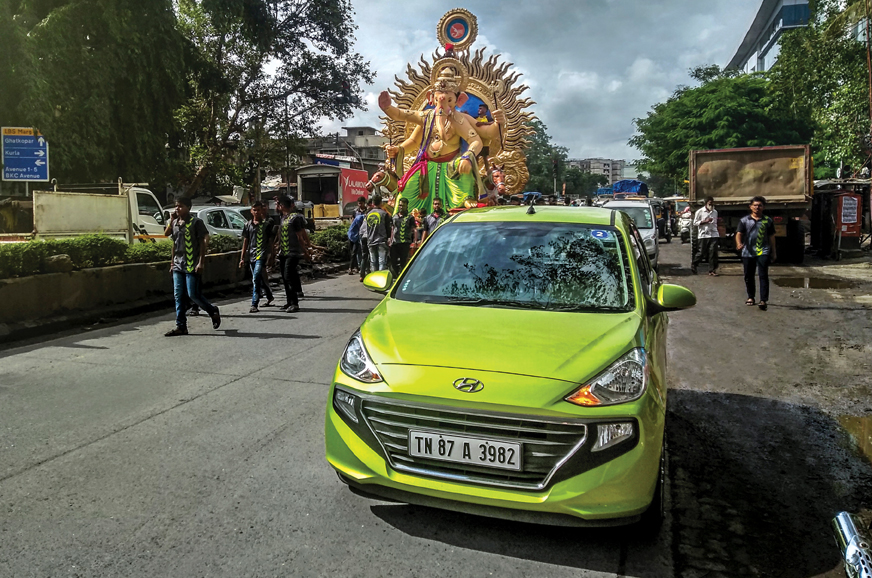
After six months, it’s time to say goodbye to our smallest long- termer, the Hyundai Santro. I was handed the keys to Hyundai’s comeback kid in February 2019, and it has remained exclusively with me, except for the times our editor, Hormazd, borrowed it. Our Santro turned quite a few heads thanks to its Grand i10-like design and striking green exterior paint, which makes it look like a more expensive car than it actually is.
I’ve put almost 7,500km on the car, most of which has been in Mumbai’s bumper-to-bumper traffic. Driving in the city and its traffic snarls meant that I actually got to spend a lot of time with the car. Thankfully, our top-spec Asta variant comes with some bells and whistles (like the touchscreen system) to keep me entertained. However, I soon noticed a few features that I sorely missed.
First up, the Santro does not get intermittent wipers – a major requirement when driving in Mumbai rains – and I had to keep switching the wipers on and off, which quickly got annoying. Hyundai should introduce this, especially since it is neither that complex, nor costly to do so. Next, the switches for the power windows are oddly positioned between the front seats and aren’t embossed or backlit, which makes it difficult to locate them without shifting your gaze from the road.
The Santro’s seats are one-piece units, like on most new hatchbacks, but are a tad small. While you do get used to them after some time, one ride in a segment rival only draws attention to how much smaller and narrower the seat base is.
The AC worked quite well in the Mumbai heat and cooled the cabin quite fast. The air-con vents can’t be shut, however, Hyundai has cleverly offered rear AC vents in the Santro and, as my family pointed out, they are actually quite helpful for faster cooling in the second row, especially during peak summer.
The highlight of the interior is the infotainment unit – the 7.0-inch touchscreen with a slick interface; it works smoothly and hasn’t troubled me one bit. It also comes with Apple CarPlay and Android Auto. While this may seem old school to most – I often play music via the AUX, and that’s something I missed having on the Santro. The screen also doubles as a reverse-camera display with guidelines, and that’s helpful when reversing into tight spots.
The Santro’s light steering may not be liked by enthusiasts but it is definitely a boon in the city. This, coupled with the car’s small footprint, makes the art of punting around Mumbai’s narrow streets much easier. The steering’s turning circle is quite small, which is quite helpful while taking U-turns. It is almost as good as my erstwhile Tata Nano long-termer in this department, which is definitely worth a mention.
During its stint with me, the Santro was used as a daily runabout; I used it to ferry my parents to various places across the city for shopping and to get errands done. While I did expect some negative feedback from them on the ride quality, surprisingly, there wasn’t any. The car’s suspension has been tuned just right for city use and it takes most of the larger potholes in its stride. On the highway, however, the suspension doesn’t feel as planted and the benchmark here would be the Tiago I used earlier.
The Santro is unique in its segment as it is powered by a four-cylinder engine; its rivals come with three-cylinder motors. After having experienced almost all of its rivals at some point or another, I can stick my neck out and say that it is the Santro’s engine that performs the best in city traffic. It does feel a bit unrefined and thrummy at higher speeds, but its true performance is seen in slower traffic, thanks to its strong bottom end. You can easily amble around at speeds as low as 20kph in second gear without the fear of the car stalling. Even below 20kph, the car motors along easily with just the clutch engaged and no throttle input. This proves to be really helpful in rush-hour traffic.
As far as fuel economy goes, the Santro delivered a real-time figure of 10.5 -11.5kpl. The number dropped a bit during the monsoon season, due to lower average speeds.
On the whole, save for some missing features, the Santro has ticked all the right boxes for me. I loved its flawless infotainment system, the friendly low-speed nature, and the tight turning circle.
The Santro was my first Hyundai and all I can say for sure is; I’ll be looking forward to more.
from Autocar India - Cars https://ift.tt/36g5NZz
No comments:
Post a Comment